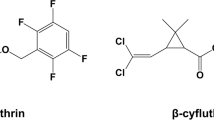Abstract
The metabolic fate of oxamyl was examined in mice and twospotted spider mites,Tetranychus urticae Koch. Mice treated intraperitoneally with oxamyl-14C eliminated 96.4% of the dose in the urine (88.7%) and feces (7.7%) by 96 hr; 75.7% of the dose was eliminated during the initial 6 hr. Organosoluble urinary radioactive material ranged from 24.6% at 6 hr to 6.5% at 72 hr and consisted of oxamyl, methylN-hydroxy-N′,N′-dimethyl-1-thiooxamimidate (DMTO), methylN-hy-droxy-N′-methyl-1-thiooxamimidate (MTO),N,N-dimethyl-1-cyanoforma-mide (DMCF), N,N-dimethyloxamic acid (DMOA),N-methyloxamic acid (MOA), methylN′-methyl-N-[(methylcarbamoyl)oxy]-1-thiooxamimidate (DMO), and several unknowns. Although some of the water-soluble urinary radioactive material was cleaved withβ-glucuronidase and aryl sulfatase, most of it was resistant to cleavage by enzymes and acid (9% HCl). Tissue levels of radiocarbon were low. Oxamyl metabolites formedin vitro by mouse liver subcellular fractions included DMCF, DMOA, MOA, DMTO, DMO, and several unknowns. Twospotted spider mites absorbed and metabolized oxamyl. The total internal radioactive material increased from 6.1% at 1 hr to 44.5% at 24 hr. Radioactive compounds isolated from two-spotted spider mites in addition to oxamyl included DMCF, DMOA, MOA, DMTO, DMO, and several unknowns.
Similar content being viewed by others
References
Bandal, S. K., and J. E. Casida: Metabolism and photoalteration of 2-sec-butyl-4,6-dinitrophenol (DNBP herbicide) and itsiso propyl carbonate derivative (Dinobuton acaricide). J. Agr. Food Chem.20, 1235 (1972).
Chang, K.-M., and C. O. Knowles: Aldicarb metabolism in twospotted spider mites. J. Econ. Entompl.71, 158 (1978).
Harvey, J., Jr., and J. C.-Y. Han: Metabolism of oxamyl and selected metabolites in the rat. J. Agr. Food Chem.26, 902 (1978).
Harvey, J., Jr., J. C.-Y. Han, and R. W. Reiser: Metabolism of oxamyl in plants. J. Agr. Food Chem.26, 529 (1978).
Kenaga, E. E., and R. W. Morgan: Commercial and experimental organic insecticides (1978 revision). Special Publication 78-1, Entomological Society of America, 79 p (1978).
Kuhr, R. J., and J. E. Casida: Persistent glycosides of metabolites of methylcarbamate insecticide chemicals formed by hydroxylation in bean plants. J. Agr. Food Chem.15, 814 (1967).
Sen Gupta, A. K., and C. O. Knowles: Galecron-14C (N′-(4-chloro-o-tolyl)-N′,N-dimethyl-formamidine) metabolism in the dog and goat. J. Econ. Entomol.63, 951 (1970).
Author information
Authors and Affiliations
Additional information
Contribution from the Missouri Agricultural Experiment Station, Columbia. Journal Series no. 8248.
Rights and permissions
About this article
Cite this article
Chang, K.M., Knowles, C.O. Metabolism of oxamyl in mice and twospotted spider mites. Arch. Environ. Contam. Toxicol. 8, 499–508 (1979). https://doi.org/10.1007/BF01056356
Received:
Accepted:
Issue Date:
DOI: https://doi.org/10.1007/BF01056356




